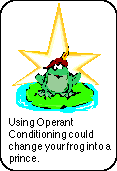CLICKER
TRAINING

CLICKER
DICTIONARY
Are you confused by all the latest
terms in dog training? Do you go to training class and have no idea
what language everyone is speaking, but you‚re pretty sure it is
not English? When you look on the web for the latest in dog training
are you constantly hearing about "clicker training" and wondering if
"clicker" is the name of some rare dog breed?
Well this article won't explain all about clicker training, but
hopefully it will translate some of the latest training lingo into
understandable English.
Anything that your dog does, good or bad, is called a  behavior. There are behaviors that you want to have happen more
often, like lying quietly while you watch television; then there are
behaviors that you don't want to happen again, like chewing the
couch.
behavior. There are behaviors that you want to have happen more
often, like lying quietly while you watch television; then there are
behaviors that you don't want to happen again, like chewing the
couch.
Figuring out how to get the good behaviors to happen more often and
the bad behaviors to happen less often is the main goal of all good
trainers, including trainers that use clickers.
Clicker trainers use one tool that most conventional trainers do not
use--the clicker. There are many misconceptions about
clickers. They are not a magic wand that instantly teach the dog to
do a perfect go out, although it sometimes appears that way. It is
also not a remote control device that can get a dog to switch
behaviors like a channel changer for your TV set. All a clicker does
is make a sound.
What the clicker trainer has done is to teach the dog that when the
dog hears the click she gets food. Thus the sound of the click is
paired with food. Food is used at first because food is a
primary reinforcer, (something that is a biological need for
all dogs). Dogs are born knowing that food is a good thing. So the
sound is paired with something that dogs already know is good.
Clicker trainers then use the sound of the click to mark
behaviors that they want to happen again. When the dog does something
"good" the trainer clicks. The dog knows that the click means food is
coming. So the behavior is associated with receiving food, and thus
likely to be repeated.
The reason the clicker trainer uses the clicker instead of their
voice to mark the behavior is because the clicker is more precise. It
is a short distinctive sound. We talk to our dogs all the time so our
voice is not distinctive. And it takes us longer to say a word then
it does to make the clicker click. The clicker more exactly marks the
exact behavior that was "good" than the human voice.
 The other
tool that good clicker trainers use is Operant Conditioning.
The principals of operant conditioning were discovered by B.F.
Skinner. Since then many people including the Baileys, Karen Pryor,
and Gary Wilkes, have used these principals to train animals. The
basic rule of Operant Conditioning is that there is an
antecedent for every behavior, then the behavior
occurs, and then there is a consequence that follows the
behavior.
The other
tool that good clicker trainers use is Operant Conditioning.
The principals of operant conditioning were discovered by B.F.
Skinner. Since then many people including the Baileys, Karen Pryor,
and Gary Wilkes, have used these principals to train animals. The
basic rule of Operant Conditioning is that there is an
antecedent for every behavior, then the behavior
occurs, and then there is a consequence that follows the
behavior.
The antecedent is what happens immediately before the behavior occurs
(for example the stop light turning red). This triggers a behavior
(hopefully stepping on the brake). The consequence is what, (or in
some cases what does not), happen immediately following the behavior
(not getting a ticket or not getting in a wreck depending on the
person driving).
The consequence determines whether you, or your dog, will be likely
to repeat that same behavior when that particular antecedent occurs
again. In the stop light example, when you saw the red light
(antecedent), you stepped on the gas and ran the red light
(behavior). A cop saw you and gave you a ticket (consequence). This
was not a good thing and the next time you see that same antecedent
(the red light) you will probably step on the brake (behavior) so
that you avoid getting a ticket (consequence).
Clicker trainers have learned that their are four
basic types of
consequences. By using
consequences to their advantage, clicker trainers can increase or
decrease the chance of a behavior happening again.
Clicker trainers also realize that how often you reinforce
a behavior has a lot to do
with how fast a dog learns a behavior and how likely a dog is to do
that behavior when a command (antecedent) is given. Reinforcement can
be fixed (every time a dog does the behavior it gets a reward)
or variable (sometimes you get the reward, sometimes you
don‚t).
Reinforcement can also be based on the number of times the dog does
the behavior (every second sit he gets a treat), which is called a
ratio, or based on time (every minute he stays he gets a
treat), which is called an interval.
Combine these and you have four types of reinforcement schedules:
fixed ratio, (every third down you get a treat), fixed
interval, (every minute you stay you get a treat), variable
ratio,  (an
average of every fifth time you sit you get a treat, but the treat
appears randomly within that average), and variable interval,
(you get reinforced an average of every 30 seconds for staying, but
the reinforcement is random within that average time span).
(an
average of every fifth time you sit you get a treat, but the treat
appears randomly within that average), and variable interval,
(you get reinforced an average of every 30 seconds for staying, but
the reinforcement is random within that average time span).
So basically all this new vocabulary around clicker training has to
do with operant conditioning. Clicker trainers have learned that by
precisely marking the behaviors they like and controlling the
consequences of those behaviors and using variable reinforcement
schedules they can get a dog that is a happy, precise, energetic
worker....if they are good enough trainers.

This page was created by and is
copyrighted to Beth
MacLehose. If you notice
any graphics I have used that are yours and you would prefer I not
use them let me know and I will remove them. Also all pictures and
text is copyrighted to me or the cited author. Please email the
author for permission to use material you find
here.